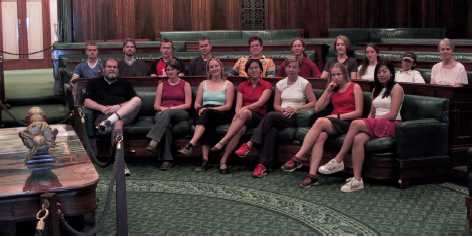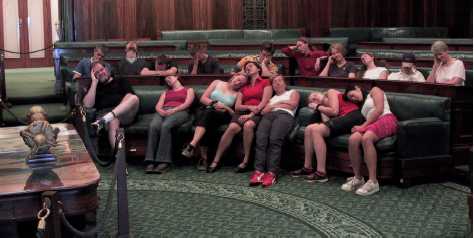- the identification of enzyme inhibitors to regulate the biosynthesis of peptide hormones;
- the production of an efficient catalyst for the hydrolytic breakdown of organophosphates;
- the discovery of multi-component one-pot methods for the synthesis of amino acids;
- the development of a prototype molecular ratchet and molecular reactors to control the regioselectivity of electrophilic aromatic substitution and carbon-carbon bond forming reactions;
- the preparation of a photochemical source of superoxide as a tool to investigate the physiological importance of this species; and
- the design and synthesis of pro- and anti-oxidants to control free radical processes.
- alter their behaviour and properties;
- produce materials for chemical processing; and
- construct molecular devices.

 Go to 2002 RSC Annual Report Index
Go to 2002 RSC Annual Report Index
Organic Chemistry
Biochemical Reactions and Molecular Recognition
Professor Chris Easton
http://rsc.anu.edu.au/research/easton.php
One theme of our research work involves the analysis of chemical reactions, particularly those occurring in biochemical systems. Results of these studies are being exploited to develop new synthetic methods and to produce physiologically active compounds with potential as pharmaceuticals. The other main field of research is in the area of supramolecular chemistry and molecular recognition, and involves the design and synthesis of molecular hosts tailored to form inclusion complexes with specific guests. Applications of this chemistry in the development of catalysts, molecular reactors, and photochemical and thermal switches are being pursued.
Highlights of our recent results include:
Personnel
highlights in 2002 include the submission of PhD theses by
C.K.Y.
Lee, G.J. Vuckovic, I. Walker, H. Onagi and S.B. McNabb. C.K.Y. Lee
was awarded a Ramsay Fellowship and S.B. McNabb a Japan Society for
the Promotion of Science Postdoctoral Fellowship, while B.J.W.
Barratt and H. Onagi were awarded prizes for their conference
presentations during the year.
Amino Acid and Peptide Free Radicals and Synthesis
Secondary metabolism of amino acids and peptides frequently gives rise to unusual products that would not be expected on the basis of laboratory precedent. This has prompted studies of the fundamental free radical reactions that may be involved. In this regard a photochemical source of superoxide has been developed in order to study biochemical processes that are thought to involve this species. Free radical reactions are associated with enzyme catalysis and a range of pathological and physiological conditions, and may be a preliminary indicator of heart disease. Results of our studies therefore have potential in regulating biochemical processes and treating human diseases. Accordingly we are exploiting the results of our research to develop inhibitors of peptidylglycine a-amidating monooxygenase, for regulating the biosynthesis of mammalian peptide hormones and treating disease states associated with the over-production of these hormones. We have also designed amino acids for incorporation into peptides to make them resistant to free radical and oxidative degradation. Other results are being applied to the asymmetric and multi-component one-pot synthesis of novel amino acids and peptides. Related work is aimed at developing new and improved methods for halogenation reactions. By finding more selective processes that occur under less vigorous conditions, it is hoped to avoid the formation of unwanted byproducts and to develop more efficient and sustainable syntheses. (with R. Barbiellini, B.J.W. Barratt, L.Y.F. Chow, A.C. Cruickshank, A. Farlow, J.B. Kelly, S.B. McNabb, A.J. Mortimer, N.A. Lorimer, L. Radom, J.S. Simpson, Z.I. Watts, and A. Wright, M. Taylor (ANUTECH Pty Ltd), M.J. Davies [Heart Research Inst., Sydney], A. Rauk [U. Calgary, Canada])
Supramolecular Chemistry and Molecular Recognition
This work exploits cyclodextrins as the basis for the construction of molecular hosts and involves the preassembly of molecules to:
Our early work in this area resulted in pharmaceutical formulations that are in everyday clinical use worldwide. In more recent studies modified cyclodextrins are being developed and exploited as molecular scaffolds for the construction of catalysts, molecular switches, and photochemical devices, and as templates to control the regio- and stereo-selectivity of reactions of included guest molecules. We have been able to design and prepare modified cyclodextrin hosts that display increased molecular recognition on binding of guest molecules. This has implications with respect to chemical separation technology (e.g. separation of isomers) through the incorporation of these materials into chromatography systems. By attaching reactive groups to cyclodextrins it has also been possible to produce catalysts with applications in chemical process technology. In this way we have been able to produce analogues of enzymes such as esterases, amidases and phosphatases. The latter have potential for application in soil and water bioremediation, to remove organophosphate pesticide residues. Another potential application of cyclodextrins in chemical process technology involves their use to control the assembly of the components of chemical reactions, to facilitate the reactions and alter the outcomes. The cyclodextrins thereby act as reaction vessels, but at the molecular level. In this regard, we have developed demonstration systems to alter by more than 4000 times the ratio of indigo and indirubin produced in competing condensation reactions and to reverse the regioselectivity of nitrile oxide cycloaddition processes. The latter reactions are also markedly accelerated compared to the analogous reactions in free solution. We have also been exploring the synthesis of cyclodextrin rotaxanes, catenanes and knots of various topologies. Where these have more than one ground state conformation, and the different states can be accessed using external stimuli, they form the basis of molecular devices such as ratchets and motors, temperature and light sensors, and photochemical frequency switches. Crystal structures of cyclodextrin host-guest complexes and rotaxanes show that these may be designed to exploit the cyclodextrins as insulators of molecular filaments formed by the guests. This has potential, for example, in the development of microelectronic systems, where the guests form conducting wires only in one direction. (with L. Barr, M.M. Cieslinski, P.G. Dumanski, J.B. Kelly, K. Lee, N.A. Lorimer, H. Onagi, M.-H. San, J.S. Simpson, and S.F. Lincoln, J.S. Locke, B.L. May [U. Adelaide], G.W. Simpson [CSIRO Molecular Science, Melbourne], R. Faulkner [Australian Vinyls Pty Ltd, Melbourne])
Other Collaborative Research
Another collaboration involves studies of the formation of melamine- urea-formaldehyde resins, and the search for alternative reagents and improved processes. We are also investigating the use of nitrile oxides in the stereocontrolled synthesis of polyfunctional molecules, particularly in order to develop a synthesis of the triol pharmacophore of the antioxidant scymnol. Other biochemical molecular recognition processes are also being analysed. (with P.A. Coghlan, M. Gebara-Coghlan, C.K.Y. Lee, A. Philbrook, X. Nguyen, D.L. Ollis, G.J. Vuckovic, I. Walker, and J. Altin [Lipotek Pty Ltd], J.M. Broadbent [McFarlane Laboratories Pty Ltd, Melbourne], N. Dunlop, G. Ryan [Orica Ltd and the UnIChe program], A. Ferrante, A. Poulos [Adelaide Medical Centre for Women and Children], G.W. Simpson [CSIRO Molecular Science, Melbourne])

t = 0 min.

t = 5 min.
The Easton group investigates the time-dependence of seminar concentration